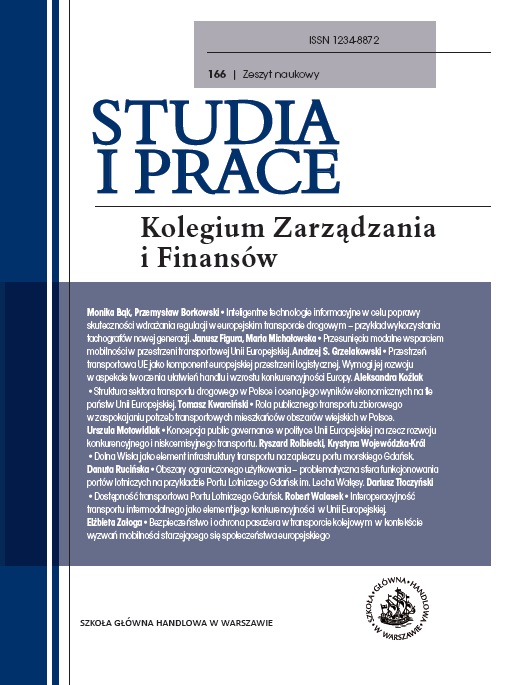Interoperability of Intermodal Transport as an Element of Competitiveness in the European Union
DOI:
https://doi.org/10.33119/SIP.2018.166.10Keywords:
transport, intermodal transport, competitiveness, interoperability, transport policyAbstract
The paper explains the importance of interoperability of European cargo transport taking account of its benefits and limitations resulting from the European Union transport policy.
The paper discusses important aspects connected with the European Union efforts to improve the competitiveness of intermodal cargo transport vis-à-vis other transport sectors. Using statistical data and comparisons thereof several benefits have been listed, such as: environmental benefits, lower emissions as well as economies of scale benefits connected with sustainable growth at economic, social, and territorial levels in all of the EU Member States. We also present factors that impede interoperability of the European intermodal transport and activities designed at reducing the impact of these factors, inter alia: ensuring the same level of infrastructure advancement in the Member States, joint management of the flows of goods within the EU, and developing Eastern Partnership.
Downloads
References
2. Dyrektywa Parlamentu Europejskiego i Rady zmieniająca dyrektywę 92/106/EWG w sprawie ustanowienia wspólnych zasad dla niektórych typów kombinowanego transportu towarów
między państwami członkowskimi (2017). Bruksela.
3. MTBiGM, Strategia Rozwoju Transportu do 2020 r. (2013). Warszawa.
4. Opinion of the European Committee of the Regions — Implementation of the 2011 white paper on transport. Official Journal of the European Union (2015/C 195/02) (2015). Brussels.
5. Rail freight transport in the EU: still not on the right track (2016). Luxembourg: European Court of Auditors.
6. Ratcliff, Ch. (2015). Wspólna polityka transportowa: informacje ogólne, Parlament Europejski do Waszych usług.
7. Rezolucja (1) w sprawie współpracy infrastrukturalnej między UE a krajami Partnerstwa Wschodniego: wspólne projekty dotyczące transportu drogowego, kolejowego i lotniczego
(2015/C 315/02) (2015). Bruksela: Dziennik Urzędowy Unii Europejskiej.
8. Road freight transport statistics (2017). Eurostat Statistics Explained.
9. Rozporządzenie Wykonawcze Komisji UE 2017/6 z dnia 5 stycznia 2017 r. w sprawie Europejskiego planu wdrożenia europejskiego systemu zarządzania ruchem kolejowym. Dz. Urz. UE
L 3 z 6 stycznia 2017 r.
10. Rozstaw szyn (2018), http://enkol.pl/Rozstaw_szyn
11. Rydzkowski, W. (2015). Przewozy intermodalne. Poznań: Biblioteka Logistyka.
12. Sprawozdanie Komisji dla Parlamentu Europejskiego i Rady (2016). Bruksela: Piąte sprawozdanie w sprawie monitorowania rozwoju rynku przewozów kolejowych (SWD (2016) 427 final).
13. SUW (2000). System samoczynnej zmiany rozstawu kół w wózkach wagonów kolejowych opracowany w 1999 r. przez inż. R. Suwalskiego.
14. The European Union Explained (2014). Brussels: Transport, European Commission, Directorate-General for Communication.
15. The Marco Polo II programme (2013). Brussels: EU Publications, European Commission, https://publications.europa.eu/en/publication-detail/-/publication/83d65bfd-037e-45a0‑ad2b-
e4ca3e7081d9/language-en/format-HTML/source-67369990
16. Towards clean and smart mobility. Transport and environment in Europe (2016). Kopenhagen: European Environment Agency (EEA).
17. Transport. Wyniki działalności w 2016 r. Activiti Results in 2016 (2017). Warszawa: GUS.
18. Wskaźnik EEA TERM01, nr 15/2016, Annual European Union greenhouse gas inventory 1990–2014 and inventory report 2016.
19. http://www.europarl.europa.eu/aboutparliament/pl/displayFtu.html?ftuId=FTU_3.4.1.html,2018.
20. Urząd Transportu Kolejowego (2018), https://www.utk.gov.pl/pl/interoperacyjnosc/informacje-o-interopera 1/11947, interoperacyjnosc-systemu-kolei.html









